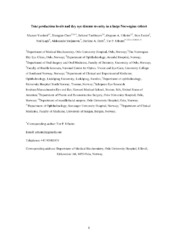Tear production levels and dry eye disease severity in a large Norwegian cohort
Yazdani, Mazyar; Chen, Xiangjun; Tashbayev, Behzod; Utheim, Øygunn Aass; Ræder, Sten; Lagli, Neil; Stojanovic, Aleksandar; Dartt, Darlene Ann; Utheim, Tor Paaske
Peer reviewed, Journal article
Accepted version
Permanent lenke
https://hdl.handle.net/1956/20541Utgivelsesdato
2018Metadata
Vis full innførselSamlinger
Originalversjon
https://doi.org/10.1080/02713683.2018.1514055Sammendrag
Purpose: To determine if the Schirmer I test (without anesthesia) cut-off value is a predictor of dry eye severity in a large Norwegian cohort of dry eye disease (DED) patients, which are grouped into six levels of tear production. Methods: Patients (n = 1090) with DED of different etiologies received an extensive dry eye work-up: osmolarity (Osm), tear meniscus height (TMH), tear film break-up time (TFBUT), ocular protection index (OPI), ocular surface staining (OSS), Schirmer I test (ST), meibum expressibility (ME), and meibum quality (MQ). Classification of dry eye severity level (DESL) and diagnosis of meibomian gland dysfunction (MGD) were also included. The cohort was divided into six groups: below and above cut-off values of 5 (groups 1 and 2), 10 (groups 3 and 4), and 15 mm (groups 5 and 6) of ST. Mann-Whitney test and Chi-Square test were used for group comparison of parameters (p ≤ 0.05). Results: The groups 1, 3, and 5 had values indicating more severe DED than the groups 2, 4, 6 with significant difference in DESL, Osm, TFBUT, OPI, OSS, and TMH. Regardless of the choice of cut-off values, there was no statistically significant difference in ME, MQ, and MGD between groups below and above selected cut-off value. When gender difference was considered in each group, significant difference was only observed for DESL (groups 2, 4, and 5), TFBUT (groups 2, 4, and 5), OPI (groups 2 and 6), and ME (group1). Conclusions: Schirmer I is a robust discriminator for DESL, Osm, TFBUT, OPI, OSS, and TMH, but not for ME, MQ, and MGD. Patients with lower tear production levels presented with more severe DED at all three defined cut-off values. Interestingly, the differences in the mean values of DESL were minimal although statistically significant. Thus, the clinical value of different Schirmer levels appears to be limited.
